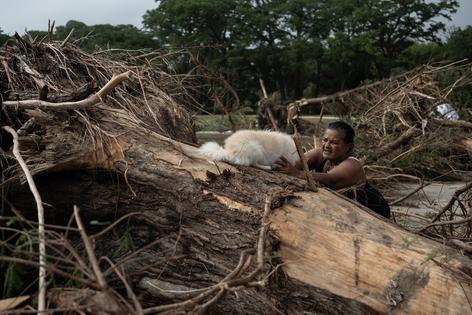My Pet World: Helping pets helps people, especially in times of crisis
As a syndicated pet columnist, I usually spend my time writing about everyday animal issues – litter box avoidance, anxious pups, and barking dogs.
But this week, I’m writing as a resident of Kerrville, Texas.
My hometown is grieving. A catastrophic flood tore through our community, claiming the lives of young girls at a summer camp, visitors here for the holiday, and residents. Many are still missing. We are all heartbroken.
There is so much grief over the human toll. Much like Hurricane Katrina – where I helped care for rescued pets in the aftermath – the weight of this loss feels just as heavy.
When Hurricane Katrina struck in 2005, it forever changed how we think about disaster response, especially when it comes to pets. An estimated 100,000 animals were left behind in the chaos. Evacuees were often forced to leave their pets behind because shelters, buses, and emergency services wouldn’t allow animals.
However, I was in San Antonio when the buses arrived with evacuees, and many of them had hidden pets in handbags and jacket pockets. With everything lost, they held onto the life that brought them some comfort.
Sadly, it was the larger dogs who were left behind. The images of them clinging to rooftops, tied to porches, or running through flooded streets sparked national outrage. That public outcry led to change.
In 2006, Congress passed the PETS Act (Pets Evacuation and Transportation Standards Act), requiring state and local emergency plans to accommodate people with household pets and service animals. The PETS Act paved the way for pet-friendly shelters, federal emergency support for animal care, and a new national understanding: pets are family, and no one should have to choose between safety and their animal’s life.
In the days following the flood, I volunteered with Kerrville Pets Alive! (KPA!), where I saw firsthand how deeply animals are now woven into our disaster response – and essential they are to our emotional recovery.
One man told me he had lost everything – his house, his car, all of it. But as he picked up pet food and bowls, he said he was grateful because he had been able to save his two dogs.
Another man, living just blocks from the Guadalupe River, had floodwaters lapping at his doorstep when emergency crews arrived. In the chaos, his dogs bolted. He ran after them, got them in the car, and escaped just in time. “I couldn’t leave without them,” he said.
Still another man shared that his dog had gotten out during the evacuation. Holding up his phone, he shared a photo. “Here’s what he looks like,” he said. “Even if he’s found dead…I would just like to know.”
In today’s emergencies, animals are no longer just casualties. They are companions in survival, grief, and recovery. They’re also partners in response. As I write, search-and-rescue teams, including specially trained dogs, are combing the riverbanks for missing loved ones. These canine heroes, working alongside their human counterparts, remind us that recovery takes many forms and many hearts.
And just as rescuers and dogs are offering help on the ground, people across the country are reaching out asking how they can help.
Here are two meaningful ways:
First, donate. No amount is too small. Disasters are expensive, and no nonprofit has a line item for catastrophe. Whether you give to the Red Cross, a local church or foundation, or an animal group like KPA!, your donation becomes part of the recovery — it provides resources where they are most needed and matter most.
Second, be prepared. The best way to honor what’s happened here in Kerrville is to be ready where you are. Disasters can happen anywhere and none of us are immune to its effects.
Pack a go-bag for your pet, which should include leashes, bowls, food, medications, and vaccination records. Make sure crates and carriers are accessible, not buried in the garage. Microchip your pets and keep ID tags on them. Know where you’ll go in an emergency, whether it’s a pet-friendly hotel, a friend’s home, or a designated shelter. Practice loading your pets into the car. When panic hits, preparation helps everyone stay calmer.
Here in Kerrville, the grief is real, but so is the gratitude – for every kind note, every prayer, every donation, and every gesture of support. We’ve felt the compassion of people not just in our own backyard, but from across the country.
In moments like these, healing begins not only with rebuilding, but with the love and support we give to one another. In the face of disaster, it’s the comfort we receive – from both humans and animals – that helps carry us forward.
========
(Cathy M. Rosenthal is a longtime animal advocate, author, columnist and pet expert who has more than 25 years in the animal welfare field. Send your pet questions, stories and tips to cathy@petpundit.com. Please include your name, city, and state. You can follow her @cathymrosenthal.)
©2025 Tribune Content Agency, LLC.
(c) 2025 DISTRIBUTED BY TRIBUNE MEDIA SERVICES, INC.












Comments